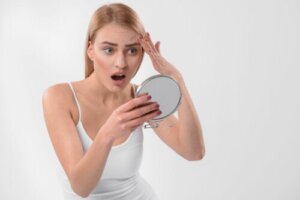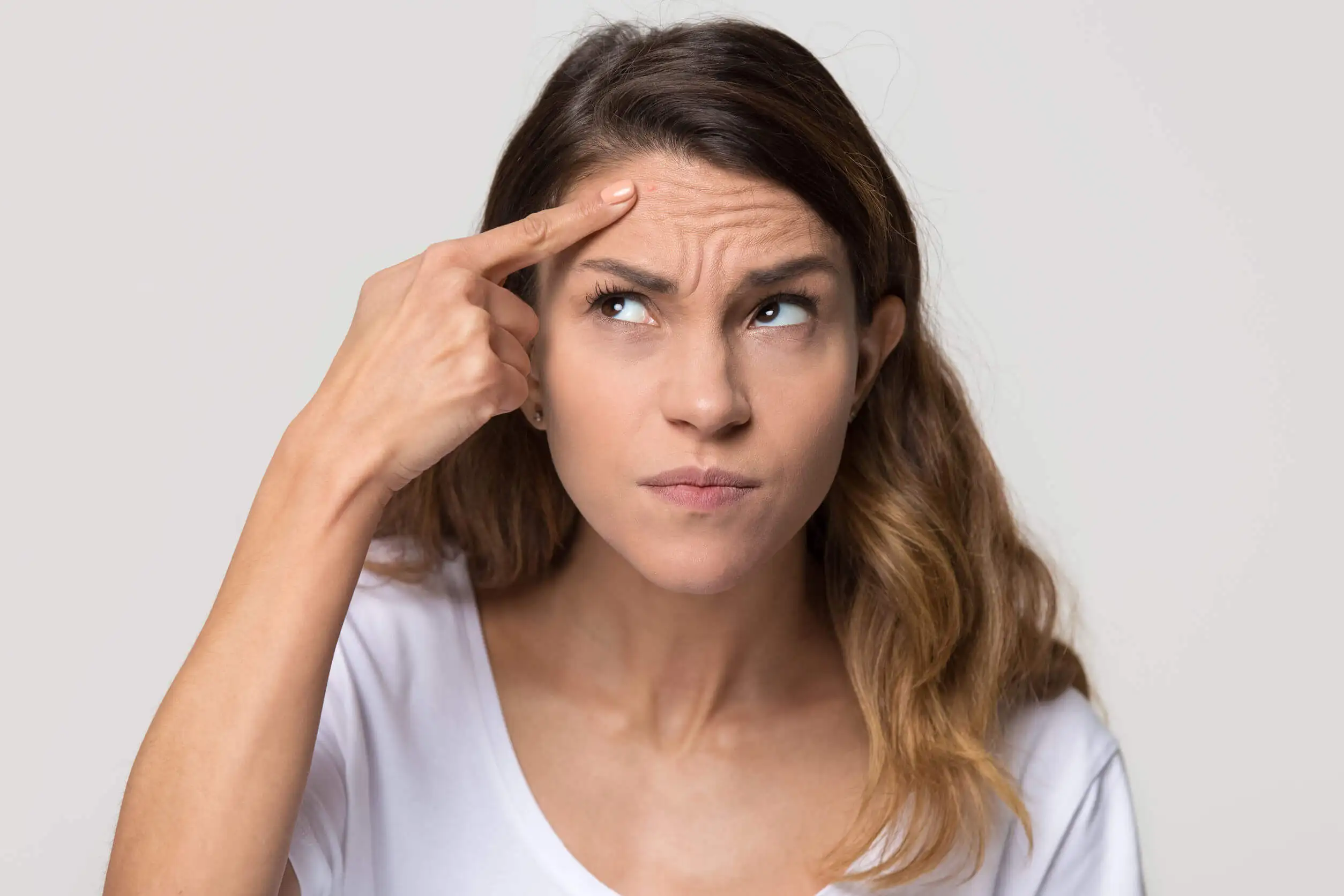Pimples on the Forehead: How to Get Rid of Them?


Reviewed and approved by the dermatologist Maria del Carmen Hernandez
Pimples on the forehead are a manifestation of acne vulgaris. Globally, it is estimated that up to 9.4% of the population suffers from acne vulgaris. However, its actual prevalence increases depending on the specific age. For example, up to 90% of adolescents develop pimples on the forehead and other parts of the face on a regular basis.
There are many misunderstandings about acne vulgaris. At first, it’s often thought to originate only from eating very greasy foods. Today we know that it’s a very complex inflammatory disorder, and one that can occur in mild, moderate, or severe forms. We’ll look at the causes of pimples on the forehead and what you can do about them.
What is acne and why does it cause pimples on the forehead?

Experts refer to acne vulgaris as an inflammatory disorder of the pilosebaceous units. The pilosebaceous units include both the hair follicle and the sebaceous gland. Inflammation of these units results, among other things, in follicular hyperkeratinization and sebaceous gland hypertrophy.
Although acne vulgaris affects the general population, it’s much more common during the onset of puberty and throughout adolescence. This is due, as evidence indicates, to increased androgen production by the adrenal glands and gonads. Also, because during this stage there’s an increased sensitivity of androgen receptors.
In addition to the face, it can also affect the following areas:
- Neck
- Chest
- Shoulders
- Upper back
As the body begins to mature, hormones stimulate the sebaceous glands to synthesize more sebum (oil). They can activate the glands to the point of being overactive, making excess sebum and too many dead skin cells.
When this happens, the pores become clogged and bacteria, especially Propionibacterium acnes, which can become trapped inside the pores and reproduce. As a consequence, the skin becomes swollen and red. This is how acne begins and pimples appear on the forehead.
Read more here: 6 Internal Problems Pimples and Spots May be Revealing
Recent studies have found that genetic and immunological factors play a leading role in the appearance of pimples on the face. Contrary to popular belief, there’s no consensus among specialists on the influence of diet on acne vulgaris. Although it’s believed that foods such as dairy products, fats, and chocolate may encourage its development, there’s no conclusive evidence to date.
How is acne vulgaris treated?
Acne vulgaris is an inflammatory disorder that can be difficult to treat. In general, experts advocate two types of treatment: topical therapy and systemic therapy. The choice of one or the other depends on the severity, characteristics, and causes of its manifestation.
Acne medications serve to reduce oil production, accelerate dermal cell renewal, fight bacterial infection, and reduce inflammation. In addition, it prevents the formation of scars.
Some drugs prescribed to treat pimples on the forehead, as well as those that appear on other parts of the body due to acne, are the following:
- Retinoids (such as retinoic acid, adapalene, tretinoin, and others).
- Antibiotics (such as minocycline and doxycycline, mainly).
- Salicylic acid, azelaic acid and trichloroacetic acid.
- Isotretinoin.
According to the specialist’s considerations, oral contraceptives, spironolactone (mainly in men) and more complete therapies such as dermatological roller, microneedles or fractionated CO2 laser can also be used. Since most episodes are mild, topical therapy is often helpful in clearing pimples on the forehead.
In general, the prognosis for acne is positive when acted upon early. Doing so is of great importance, as it reduces the possibility of sequelae in the form of scarring. Skin hygiene is also part of its treatment; and habits such as not rubbing, pinching or squeezing pimples on the face and other parts of the body should be taken on board in order to avoid complications.
Pimples on the forehead: superficial obstruction of the skin

People with sporadic pimples on the forehead are likely to have maintained inadequate facial hygiene or used beauty products that aren’t suitable for their skin type for a certain period of time.
The pores of the skin are very sensitive to dirt. When dirt penetrates the pores it can cause them to become clogged very quickly, especially if the recommended cleansing products aren’t used.
Daily cleansing serves to deeply remove the oil found in the pores. We leave you with some basic recommendations that will help you get rid of pimples on the forehead:
- Use mild skin cleansers instead of scrubs and soaps. Avoid strong or very smelly products at all costs.
- If you opt for cosmetic and skin care products, make sure they are non-comedogenic. If a specific product gives you pimples or blackheads, stop using it.
- Avoid rubbing your face intensely with a towel to dry it.
- Purchase oil-free sunscreens.
You can also use home remedies for acne vulgaris such as aloe vera, honey, apple cider vinegar, and others. These can help you fight pimples on the forehead when their manifestation is mild. As we have already advised you, moderate or intense episodes should be treated by a professional.
Prevention is a great option
Pimples on the forehead can appear for several reasons. There are some that we can’t control, but others we can prevent. Know your skin type and establish a facial hygiene routine with the right products.
Wash immediately after sports or excessive sweating, avoid using accessories that squeeze your forehead (such as hats or scarves), avoid prolonged exposure to the sun, and wash your hands frequently – these are effective methods of prevention. If the problem is constant or is escalating in intensity, consult a dermatologist.
All cited sources were thoroughly reviewed by our team to ensure their quality, reliability, currency, and validity. The bibliography of this article was considered reliable and of academic or scientific accuracy.
- Argote, A., Mora, Ó. E., González, L. C., Zapata, J. M., Uribe, D. (2014). Aspectos fisiopatológicos del acné. Revista de la Asociación Colombiana de Dermatología y Cirugía Dermatológica, 22(3), 200-206. https://revista.asocolderma.org.co/index.php/asocolderma/article/view/271
- Bagatin, E., Costa, C. (2020). The use of isotretinoin for acne–an update on optimal dosing, surveillance, and adverse effects. Expert Review of Clinical Pharmacology, 13(8), 885-897. https://pubmed.ncbi.nlm.nih.gov/32744074/
- Dall’Oglio, F., Nasca, M. R., Fiorentini, F., Micali, G. (2021). Diet and acne: review of the evidence from 2009 to 2020. International Journal of Dermatology, 60(6), 672-685. https://pubmed.ncbi.nlm.nih.gov/33462816/
- Institute for Quality and Efficiency in Health Care [IQWiG]. (2013). Skin care for acne-prone skin. Consultado el 15 de junio de 2023. https://www.ncbi.nlm.nih.gov/books/NBK279208/
- Kurokawa, I., Nakase, K. (2020). Recent advances in understanding and managing acne. F1000Research, 9, 792. https://www.ncbi.nlm.nih.gov/pmc/articles/PMC7391011/
- Leung, A. K., Barankin, B., Lam, J. M., Leong, K. F., Hon, K. L. (2021). Dermatology: how to manage acne vulgaris. Drugs in context, 10. https://www.ncbi.nlm.nih.gov/pmc/articles/PMC8510514/
- Lu, J., Cong, T., Wen, X., Li, X., Du, D., He, G., Jiang, X. (2019). Salicylic acid treats acne vulgaris by suppressing AMPK/SREBP 1 pathway in sebocytes. Experimental dermatology, 28(7), 786-794. https://pubmed.ncbi.nlm.nih.gov/30972839/
- Ogé, L. K., Broussard, A., Marshall, M. D. (2019). Acne vulgaris: diagnosis and treatment. American family physician, 100(8), 475-484. https://pubmed.ncbi.nlm.nih.gov/31613567/
- Sutaria, A. H., Masood, S., Schlessinger, J. (2023). Acne vulgaris. StatPearls. https://www.ncbi.nlm.nih.gov/books/NBK459173/
This text is provided for informational purposes only and does not replace consultation with a professional. If in doubt, consult your specialist.








